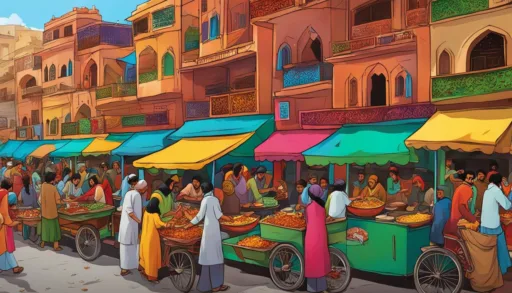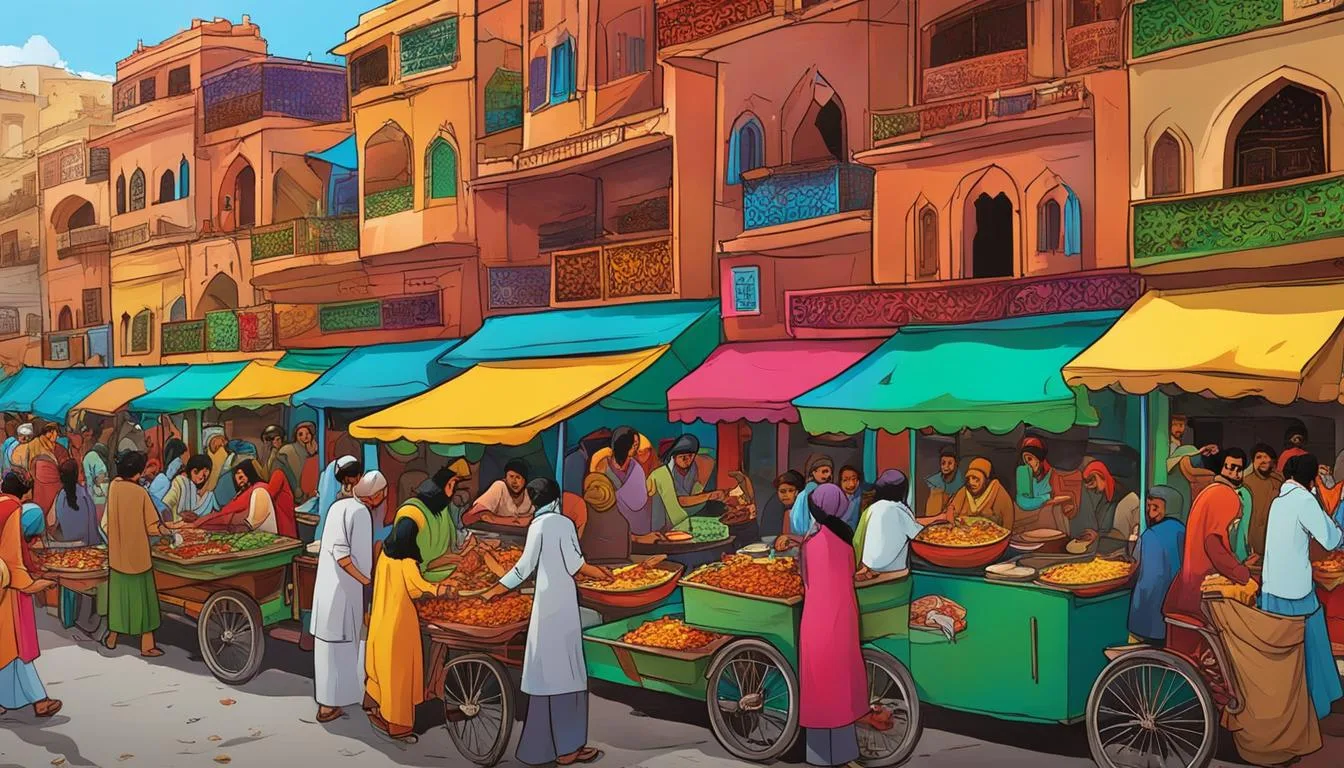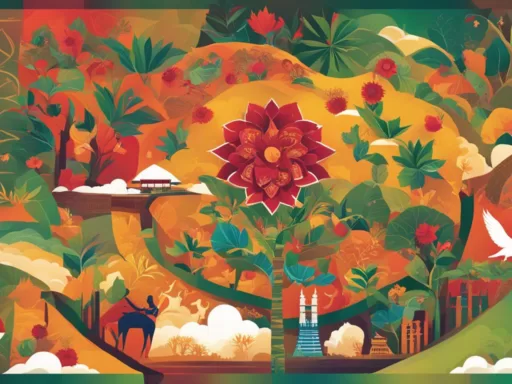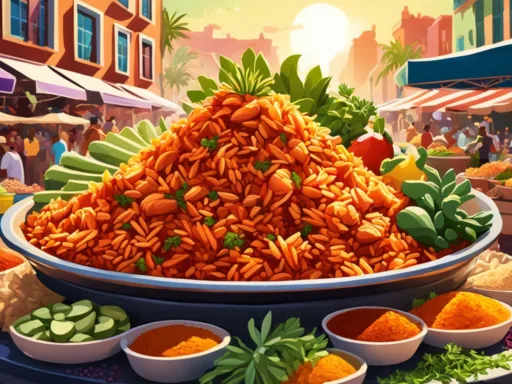Take a moment to consider the transformative power of food: a universal language that speaks to our need for nourishment, comfort, and connection. As we embark on culinary journeys around the globe, we find that the heart of a nation’s culture often pulsates within its cuisine. The diverse dishes of Pakistan invite such a discovery, offering more than just sustenance—they present a story of convergence, resilience, and diversity.
Embarking on a Pakistani culinary tour promises not just an explosion of flavors but also an exploration into the fabric of Pakistani society. The agility of chefs to weave waves of spice into a delicate balance has made rich Pakistani cuisine increasingly admired on the global stage. Yet, many still remain unaware of the depth and variety found in Pakistan’s gastronomic offerings. Join us as we delve into the secrets behind this flavorful tapestry, and the richness that Pakistani kitchens are poised to share with the world.
Key Takeaways
- The centrality of spices in uniting the diverse culinary traditions of Pakistan.
- An introduction to the intricate blend of flavors that define Pakistan’s regional specialties.
- Insight into how Pakistani cuisine reflects the nation’s rich history and cultural diversity.
- The growing global fascination with Pakistani food as a catalyst for cultural exchange.
- The role of food tourism in driving economic growth and job opportunities in Pakistan.
- A preview into the authentic experiences awaiting those who seek to explore Pakistani food and its social significance.
Pakistani Culinary Tour: An Introduction
Embarking on a Pakistani Culinary Tour offers a unique lens through which to view and appreciate the country’s rich cultural tapestry. By choosing to explore Pakistani food, gastronomes and curious travelers alike will find themselves at the crossroads of ancient traditions and contemporary practices. Each dish served is a story of the land, revealing secrets of regional terroir, ancestral wisdom, and the communal spirit that is foundational to Pakistani hospitality.
The Role of Cuisine in Pakistan’s Cultural Tapestry
The vibrant hues of Pakistani cuisine are integral threads within the broader cultural tapestry of the nation. The act of dining is not just a means to satiate hunger but a ritual that pays homage to the nation’s history, its people, and the bounties of the land. To truly immerse oneself in the Pakistani way of life, one must sit at the table of diversity and enjoy an authentic Pakistani cuisine experience, which is as varied as the language, attire, and customs found across the nation.
What Makes a Culinary Tour in Pakistan Unique?
What distinguishes a food tour in Pakistan from other gastronomic excursions around the world is the unparalleled direct dive into indigenous culture and the booming imprint it leaves on the tourism industry. A journey through Pakistan’s culinary scene is an odyssey through flavors that have evolved over millennia, perfected by cooks of the present day. From the rich seafood dishes of Karachi to the BBQ delicacies of Lahore and Balochistan’s meat wonders, every region opens up like a chapter in a spice-laden storybook, beckoning travelers to read on. The participatory role visitors take in this narrative not only satisfies their epicurean cravings but also contributes to the sustenance of local communities, thus positioning food tour Pakistan as an enriching economic pillar.
As you prepare to chart your own course through the aromatic streets and bustling markets of this South Asian gem, rest assured that the experiences you collect will piece together into a gastronomic quilt of unforgettable moments—each taste an invitation to learn, to celebrate, and to remember the wonders of Pakistan’s profound culinary legacy.
The Historical Evolution of Pakistani Cuisine
The taste of Pakistan food tour offers an exploratory adventure into a cuisine rich in culinary heritage and historical influences. The savory journey through Pakistani food history is akin to a living museum where each dish portrays a chapter from the nation’s storied past. Spanning from the fertile crescent of the Indus Valley Civilization to the modern-day, these flavors are a testament to the array of cultures that have woven their threads into the fabric of Pakistani cuisine.

The Persian legacy bequeathed the rich tradition of rice dishes adorned with saffron. The Arabs introduced meat-cooking techniques that have persisted in the variety of kebabs found nationwide. The influence of the Mughals is perhaps most profound, infusing the local diet with luxurious ingredients and the opulence of feasts that continue to tantalize palates. Finally, the British colonial era left behind a fondness for tea, baked goods, and a certain formality in dining practices that still lingers in some circles.
- Indus Valley Civilization: The agricultural bounty set the stage for food richness.
- Persians: Brought sumptuous rice dishes and the beloved use of saffron.
- Arabs: Introduced meat delicacies, enhancing the repertoire of Pakistani meats.
- Mughals: These royals heralded the era of indulgent feasts with exquisite spices.
- British: Tea culture and baked delights became part of the colonial gastronomic legacy.
Today, spices such as coriander, cumin, and garam masala are culinary cornerstones, each addition telling a story of interaction and assimilation. To participate in a taste of Pakistan food tour is to embark on a delicious journey through time, unraveling the dynamic narrative of this land’s culinary evolution. The palates of visitors and locals alike are graced by an intricate ballet of flavors, each step a product of historical encounters and exchanges.
“To know the history of Pakistani cuisine is to understand the rich tapestry of cultures that have danced across this land, each leaving behind a unique flavor.” – Celebrated Pakistani Chef
Thus, a food experience here is not a mere indulgence in gastronomy but a form of communion with the history and legacy of Pakistan. It’s an invitation to touch, taste, and savor the heritage that has simmered in its pots and pans, creating a repertoire that is as diverse as it is delicious.
Regional Delicacies and Provincial Specialties
Exploring the vast landscape of Pakistan is not merely a visual journey; it is a culinary excursion that vividly illustrates the diversity of regional Pakistani cuisine. Each province serves up its own slice of the country’s rich tapestry of tastes and aromas, beckoning food lovers to indulge in a spectrum of traditional flavors. From the agricultural breadbasket of Punjab to the coastal delicacies of Karachi, down to the earthy tones of Northern Pakistan, these culinary experiences are far more than just nourishment; they’re cultural expressions.
Punjab’s Hearty Feasts: A Taste of the Agricultural Heartland
The fertile plains of Punjab are not only agricultural marvels but are also home to some of Punjab’s hearty dishes that have become integral to Pakistani cuisine. Majestic feasts that boast a bounty of spices and flavors, such as the delectable biryani and the rich, slow-cooked delight called nihari, reflect the soul of this region.
Coastal Flavors: Karachi’s Seafood and Spice
Heading to the bustling streets of Karachi, one is greeted with a fusion of tastes, where the aromatic spices meet the fresh bounties of the sea. Karachi seafood offerings like fiery prawn curries and grilled fish are culinary treasures that echo the city’s cosmopolitan spirit and its historical role as a prominent port city.
The Mountainous Majesty of Northern Pakistan’s Dishes
In the far reaches of Northern Pakistan, the cuisine takes on a unique character shaped by the rugged landscape and cooler climate. Here, food does more than satiate; it offers warm comfort against the backdrop of towering peaks. The culinary experiences in this region boast hearty, meat-based stews and the use of dried fruits and nuts, encapsulating the essence of Northern Pakistan culinary experiences.
| Region | Signature Dish | Main Ingredients | Flavor Profile |
|---|---|---|---|
| Punjab | Biryani | Rice, Chicken, Yogurt, Spices | Robust & Aromatic |
| Karachi | Prawn Curry | Prawns, Tomatoes, Chili, Garlic | Spicy & Tangy |
| Northern Pakistan | Meat Stew | Mutton, Lentils, Wheat, Spices | Rich & Hearty |
Certainly, the regional specialities of Pakistan tell a story of place and people, deeply rooted in history and the abundant natural resources of each locale. By honouring these dishes, we pay homage to the regions they come from and the diverse culinary heritage of Pakistan that continues to captivate palates around the world.
Signature Spices and Cooking Techniques of Pakistan
Embarking on food adventures in Pakistan is akin to entering a world where the authentic flavors are the stars of every dish. Central to this culinary excellence are the Pakistani spices and cooking techniques that have been perfected over generations. Indeed, no food journey here is complete without a deep dive into the secrets of its spice-laden delights.
Every meal is a testament to the careful curation of spices – cumin, coriander, turmeric, and chili are not mere ingredients, but artisans of taste, deftly painting each dish with vibrant colors and profound depth. The art of slow-cooking these spices unlocks their full potential, infusing meats and vegetables with an irresistible allure. Let’s take a closer look at some of the quintessential spices and methods that amplify the charm of Pakistani cuisine.
| Spice | Characteristics | Common Uses |
|---|---|---|
| Cumin | Earthy, warm, slightly bitter | Curries, lentils, rice dishes |
| Coriander | Fragrant, citrus-like | Chutneys, marinades, spice rubs |
| Turmeric | Bright, pungent, slightly bitter | Soups, stews, rice preparations |
| Chili | Fiery, sharp, with varying levels of heat | Meat dishes, vegetable stir-fries, condiments |
In addition to these spices, the traditional tandoor oven is a cornerstone of Pakistani cookery. This ancient technique gifts meats and breads with a smoky richness that is impossible to replicate with modern appliances. Witnessing tandoori cooking is a spectacle in itself, as skilled chefs orchestrate a symphony of flames and flavors.
“To cook is to weave a tapestry of aroma, flavor, and texture – a philosophy deeply embodied by Pakistani chefs and home cooks alike.”
Whether you are strolling through the bustling lanes of Lahore or enjoying a quiet evening in a local home, the aromatic whispers of these spices are your constant companions, inviting you into an unforgettable cultural immersion. As a food adventurer, your journey through Pakistan is a vibrant mosaic of taste, seasoned generously with history and passion.
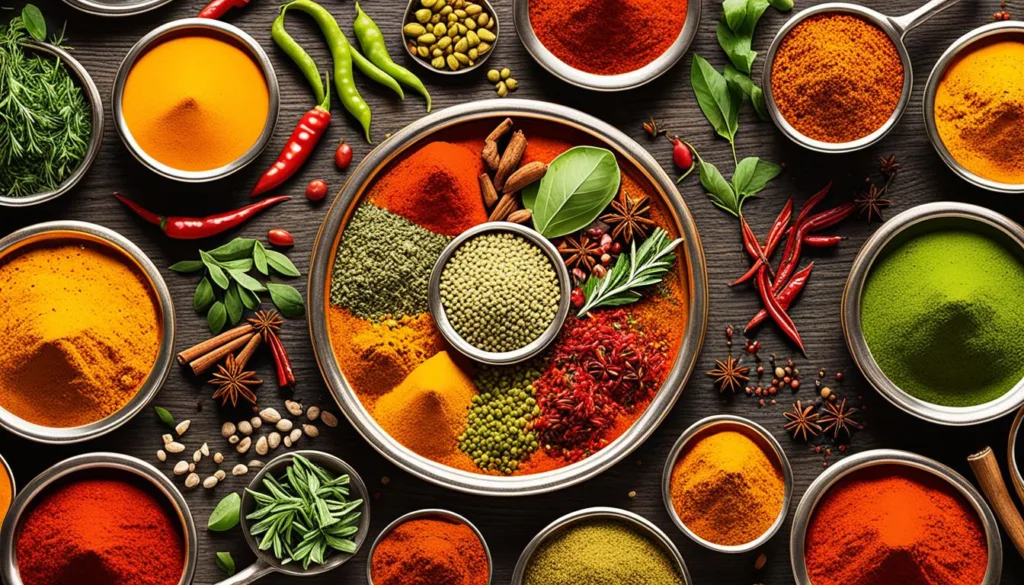
- Experience the harmony of spices in traditional biryanis
- Discover the slow-cooked wonders of haleem and nihari
- Relish the smoky treasures cooked in clay tandoors
- Savor the rich stews that simmer to perfection
Immerse yourself in the culinary heart of Pakistan, and let every bite take you closer to the soul of this vibrant land. Here, cooking is not just a practice but an age-old art – a celebration of authentic flavors that you are invited to explore and cherish.
From Street Eats to Fine Dining: The Spectrum of Pakistani Foodscapes
As one embarks on a food adventure through Pakistan, they are greeted with an array of flavors catering to every palate, from bustling bazaars serving Pakistani street food to the hushed ambience of high-end restaurants offering fine dining in Pakistan. This culinary exploration of Pakistan ranges from simple, mouth-watering snacks to elaborate, spice-infused luxury fare, illustrating the dynamic diversity of this nation’s culinary arena.
The Street Food Scene: A Culinary Adventure in Every Corner
On every street corner and winding alley, you’ll find a sensory overload with vendors offering the quintessential Pakistani chaat, samosas, and kebabs. The street food scene is intrinsic to Pakistan’s culture, serving up not just food but tradition wrapped in the aroma of freshly cooked delicacies.
Pakistani street food does not merely fill the stomach; it entices the soul, encapsulating the spirit of the nation.
Fine Dining in Pakistan: A Blend of Tradition and Innovation
Fine dining in Pakistan carries the torch of tradition into the realms of modern gastronomy. Top chefs are curating menus that blend time-honored recipes with inventive techniques, catering to a growing demand for upscale Pakistani cuisine that respects its roots while reaching for new heights.
| Dining Experience | Features | Popular Choices |
|---|---|---|
| Street Food | Quick, accessible, and authentic | Chaat, Samosas, Pani Puri |
| Fine Dining | Sophisticated, innovative, and refined | Nihari, Biryani, Haleem |
Pakistani Sweets and Desserts: The Perfect End to a Culinary Exploration
Embarking on a culinary journey through Pakistan’s savory dishes is only half the adventure; the true essence of the country’s rich gastronomic culture is found in its delectable sweets and desserts. A testament to the culinary craftsmanship of Pakistan, these luscious creations are more than mere treats—they’re a celebration of tradition and flavor woven into the fabric of everyday life.
Luscious Gulab Jamun and Creamy Kheer
The syrupy delight of Gulab Jamun, deep-fried dough balls soaked in rose-scented syrup, is a quintessential Pakistani treat that transcends regional preferences. Similarly, Kheer, lovingly prepared with rice, milk, and a delicate assortment of nuts and cardamom, is the pinnacle of comfort desserts, gracing tables during festive occasions and serene nights alike.
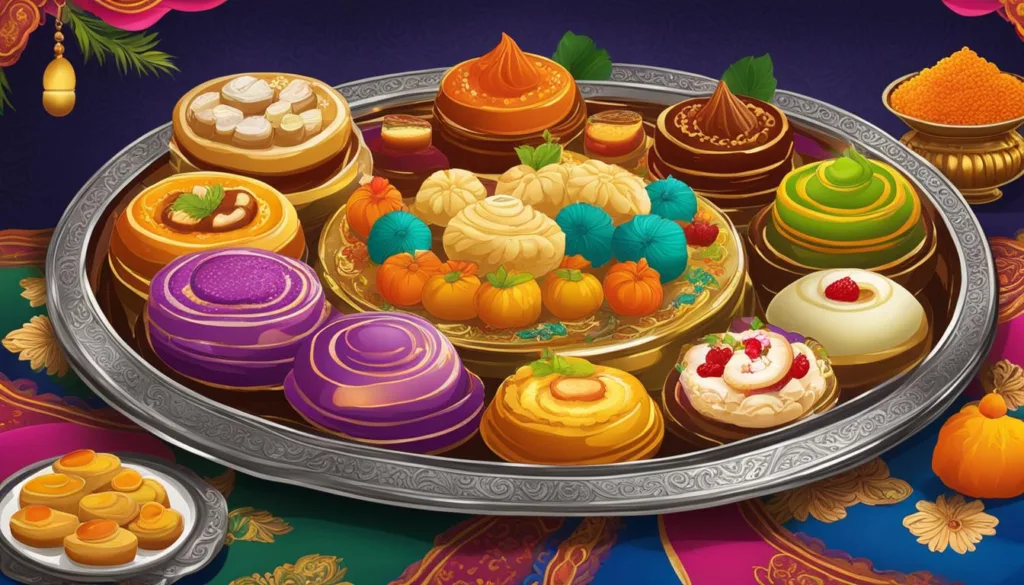
Ras Malai and Baklava: A Treat for the Sweet Tooth
Feathersoft Ras Malai, with its cheese curd patties drenched in creamy milk, offers a taste of decadence, while the multilayered Baklava, a sweet legacy of the Middle Eastern influence in Pakistani desserts, presents an indulgent union of nuts, phyllo pastry, and a cascade of sweet syrup. No culinary journey is complete without these delights as they provide a perfect finale to the complex dance of flavors found in Pakistani meals.
- Gulab Jamun – A beloved classic soaked in sweet, aromatic syrup.
- Kheer – A timeless rice pudding with the richness of milk and nuts.
- Ras Malai – Delightfully light cheese dumplings in a sweet milk base.
- Baklava – Crisp pastry layers filled with honeyed nuts, a sweet fusion of cultures.
Each bite of these Pakistani sweets and desserts is a story in itself, revealing the history, the warmth of home kitchens, and the generosity of Pakistani hospitality. Venturing through this variety of sweet confections reminds us that every meal, much like every journey, deserves a memorable ending.
Authentic Home Cooking: The Heart of Pakistani Cuisine
At the core of Pakistan’s rich culinary landscape is the tradition of home-cooked Pakistani food. Just as every family has its own treasured heirlooms, so too does each hold dear a collection of traditional Pakistani recipes, meticulously prepared and bursting with the essence of authenticity. An authentic culinary experience in Pakistan often takes one within the welcoming walls of a local home, where the air is ripe with the scent of simmering spices and the warmth of familial love.
These genuine culinary treasures are where one can truly understand the Pakistani culture, as each dish is a testament to the nation’s hospitality and the importance of food in its social fabric. To illustrate the significant role of home-style cooking, let us delve into some of the quintessential Pakistani dishes crafted in domestic kitchens across the country.
| Traditional Dish | Main Ingredients | Cooking Method |
|---|---|---|
| Haleem | Wheat, barley, meat, lentils, spices | Slow-cooked to perfection |
| Nihari | Beef or lamb, flour, spices | Stewed for hours, often overnight |
| Biryani | Rice, meat or vegetables, yogurt, spices | Layered and steamed, for flavor infusion |
| Karhai | Meat, tomatoes, green chili, spices | Cooked in a wok, with rich gravy |
The meticulous preparation of these meals, deeply rooted in the customs passed down from generation to generation, underscores the essence of Pakistani cooking. Binding the flavor profiles of each dish is the symphony of spices that is unparalleled in its ability to convey depth and character. Such recipes are cherished, not merely for their palatable delight but also for their cultural significance—they serve as portraits of history, painted with the brushstrokes of tradition on the canvas of family gatherings.
It is in the creation and sharing of these meals that one finds the real heart of Pakistan—a heart that beats strongly within the walls of its homes, in the kitchens where families come together, and through the hands that prepare these lovingly crafted feasts. Whether it’s the complex layering of a biryani or the soothing warmth of a slow-cooked haleem, home-cooked Pakistani food is the vessel through which the spirit of the nation’s heritage is preserved and savored.
Global Influences and the Diverse Fans of Pakistani Food
The allure of Pakistani cuisine extends far beyond its borders, casting a spell on a constellation of fans around the world. Its rich tapestry of flavors has permeated the global culinary landscape, influencing dining habits and inspiring chefs worldwide. As dishes like **biryani**, **kebabs**, and **curry** land on menus in diverse locales, the global influence on Pakistani cuisine is unmistakable. This worldwide love affair isn’t just about savoring a dish; it’s about the stories and traditions encapsulated in each bite, appealing to gourmands seeking authenticity and adventure.
Expatriates and culinary explorers have played a pivotal role in ushering the flavors of Pakistan into international food scenes. As cities globally boast vibrant, multicultural communities, Pakistani eateries have become fixtures in the tapestry of urban dining. They’ve given both expats and new patrons a taste of home or an invitation to explore the unknown. Thus, the diverse fans of Pakistani food include not just those of Pakistani descent, but a myriad of individuals drawn to its complexity and zest.
The exchange goes both ways; chefs in Pakistan and abroad derive culinary inspiration from this intermingling of cuisines, churning out inventive fusion dishes that redefine tradition. This adaptability and openness to reinterpretation have encouraged a creative culinary dialogue that highlights the dynamic nature of Pakistani cuisine. From food trucks in Los Angeles serving Pakistani tacos to high-end restaurants in New York crafting refined subcontinental dishes, this cuisine’s versatility reinforces its standing as a global ambassador of flavor and heritage.
FAQ
The Role of Cuisine in Pakistan’s Cultural Tapestry
Pakistani cuisine is not just about food; it’s a vibrant part of the country’s cultural tapestry. Each dish tells a story of the area’s history, traditions, and the people who have contributed to its rich culinary heritage. A Pakistani culinary tour offers an authentic Pakistani cuisine experience, allowing travelers to explore Pakistani food and understand its role in the daily life and celebrations of locals.
What Makes a Culinary Tour in Pakistan Unique?
A culinary tour in Pakistan stands out due to the vast diversity of regional dishes and authentic flavors that cannot be found elsewhere. Visitors on a food tour in Pakistan can expect to be taken on a journey through the cultural tapestry of the country, tasting specialities from different provinces and learning about the intricate history and techniques behind each dish.
The taste of Pakistan’s food tour offers a deep dive into the history and culinary heritage of the region. From the influences of the Mughals to the British colonization, each period has left an indelible mark on the flavors and techniques seen in Pakistani cooking today. Understanding these historical influences enriches the food adventure, as each dish is a chapter in the nation’s storied past.
Punjab’s Hearty Feasts: A Taste of the Agricultural Heartland
Punjab, the agricultural heartland, provides a taste of Pakistan that is rich, hearty, and full of robust spices. A culinary tour here involves indulging in dishes like biryani and nihari, showcasing the region’s penchant for flavorful, satisfying meals.
Coastal Flavors: Karachi’s Seafood and Spice
Karachi offers a culinary expedition like no other, with the city’s coastal location influencing a menu heavy on spicy seafood and rich curries. During a tour, visitors can experience the unique fusion of flavors that this port city has to offer.
The Mountainous Majesty of Northern Pakistan’s Dishes
Northern Pakistan offers unique dishes shaped by its cooler climate and mountainous landscapes. Culinary tours here allow for an exploration into the hearty, nourishing fare favored by the locals in these regions.
Pakistani cuisine is celebrated for its judicious use of signature spices and time-honored cooking techniques. Experiencing food adventures in Pakistan means diving into the authentic flavors brought out by methods such as slow cooking and tandoor baking, offering a truly authentic flavors experience.
The Street Food Scene: A Culinary Adventure in Every Corner
The Pakistani street food scene provides an unfiltered culinary adventure, with delights such as chaat, samosas, and golgappas found in every nook and cranny. These authentic bites offer a taste of the local palate and are essential to the culinary exploration of Pakistan.
Fine Dining in Pakistan: A Blend of Tradition and Innovation
For those seeking a more upscale food adventure, fine dining in Pakistan offers a harmonious blend of traditional flavors with modern culinary techniques. These establishments provide an environment where traditional Pakistani cuisine meets contemporary innovation.
Luscious Gulab Jamun and Creamy Kheer
No Pakistani culinary journey is complete without indulging in the sweet treats of the region, like the syrupy Gulab Jamun or the creamy Kheer. These desserts are a testament to the sweet aspect of Pakistani cuisine and a must-try for anyone on a food tour of the country.
Ras Malai and Baklava: A Treat for the Sweet Tooth
Desserts such as Ras Malai and Baklava offer a delightful experience for those with a sweet tooth, providing an insight into the richness and diversity of Pakistani sweets and the craftsmanship behind them.
Authentic culinary experiences in Pakistan are often rooted in home cooking. Dishes like haleem and nihari prepared in a Pakistani household showcase the deep connection to tradition and the transfer of recipes through generations, making it the heart of the country’s culinary essence.
Pakistani cuisine has gained fans worldwide, with its unique flavors influencing global food trends and inspiring new culinary creations. This global appreciation underscores the diversity and adaptability of Pakistani food, which continues to inspire and be reinterpreted around the world.
What can I expect from a Pakistani culinary tour?
Expect to embark on a journey through a myriad of flavors, from the spicy street food of Lahore to the sophisticated and aromatic curries of Karachi. You’ll discover the cultural significance of each dish and the stories behind Pakistan’s rich culinary heritage.
How does Pakistani cuisine differ across regions?
The cuisine varies significantly, with each province offering its own specialities. Punjab is known for its rich, spiced meat dishes, Sindh for its exquisite seafood, Balochistan for its fire-grilled meats, and Khyber Pakhtunkhwa for its pastoral fare, each providing a distinct taste reflective of the local geography and culture.
Are there options for vegetarians on a Pakistani food tour?
Absolutely! Pakistani cuisine has a plethora of vegetarian options, from spicy lentil dishes like daal to vegetable curries and a wide variety of breads and rice dishes. Street food options such as chaat and samosas are also largely vegetarian-friendly.
What are some not-to-miss dishes on a food tour in Pakistan?
Ensure you try the likes of biryani, a layered rice and meat dish, nihari, a slow-cooked meat stew, karahi, a type of curry, and BBQ specialties like seekh kebabs. Don’t miss out on sweet treats like gulab jamun, jalebi and the creamy vermicelli dessert known as seviyan.
How has Pakistani cuisine been influenced by its history?
The culinary evolution of Pakistan has been shaped by historic invasions and trade routes, integrating cooking techniques and ingredients from Persian, Arab, Mughal, and British civilizations. This has led to a complex cuisine that boasts a wealth of flavors and dishes unique to the country.
Can I participate in cooking classes during my Pakistani culinary tour?
Cooking classes are a popular part of many Pakistani food tours, offering participants a hands-on experience in preparing traditional dishes alongside local chefs or home cooks, which serves as a great way to delve deeper into the culinary culture.
Is Pakistani food very spicy?
Pakistani cuisine can be quite spicy, but it’s all about the balance of flavors. While some dishes are hot, there is always a range of dishes with more moderate spiciness, and chefs can often adjust the heat to suit your palate.
What is the best time of year to go on a Pakistani culinary tour?
The best time to go on a food tour in Pakistan is from October to March, when the weather is cooler and more conducive to exploring the various food scenes throughout the country, from bustling markets to serene orchards and fields.
